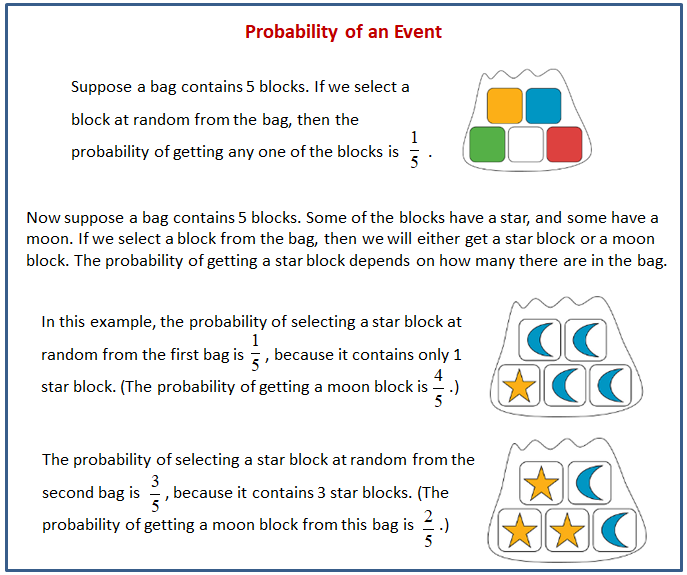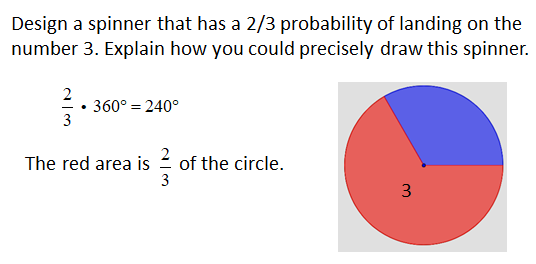Illustrative Mathematics Grade 7, Unit 8, Lesson 5: More Estimating Probabilities
Learning Targets:
- I can calculate the probability of an event when the outcomes in the sample space are not equally likely.
- I can explain why results from repeating an experiment may not exactly match the expected probability for an event.
Related Pages
Illustrative Math
Grade 7
Lesson 5: More Estimating Probabilities
Let’s estimate some probabilities.
Illustrative Math Unit 7.8, Lesson 5 (printable worksheets)
Lesson 5 Summary
The following diagram shows how to find the probability of an event given the sample space.

Lesson 5.1 Is it Likely?
- If the weather forecast calls for a 20% chance of light rain tomorrow, would you say that it is likely to rain tomorrow?
- If the probability of a tornado today is 1/10, would you say that there will likely be a tornado today?
- If the probability of snow this week is 0.85, would you say that it is likely to snow this week?
Lesson 5.2 Making My Head Spin
Work with your group to decide which person will use each spinner. Make sure each person selects a different spinner.
Answer the first set of questions on your own.
Spinner A
Open Applet
Spinner B
Open Applet
Spinner C
Open Applet
Spinner D
Open Applet
- Spin your spinner 10 times and record your outcomes.
- Did you get all of the different possible outcomes in your 10 spins?
- What fraction of your 10 spins were 3s?
Work with your group to answer the next set of questions. - Next, share your outcomes with your group and record their outcomes.
a. Outcomes for spinner A:
b. Outcomes for spinner B:
c. Outcomes for spinner C:
d. Outcomes for spinner D: - Do any of the spinners have the same sample space? If so, do they have the same probabilities for each number to result?
- For each spinner, what is the probability that it ends on the number 3? Explain or show your reasoning.
- What is the probability that you will spin something other than a 3 on each spinner? Explain or show your reasoning.
- When Noah spun spinner D, he put it on his closed binder and never got a 1 in all 10 spins. How might you explain this problem?
- When Han spun spinner C, he never got any 3s, so he says that the probability of getting a 3 is 0. How might you explain this problem?
Are you ready for more?
Design a spinner that has a 2/3 probability of landing on the number 3. Explain how you could precisely draw this spinner.
Lesson 5.3 How Much Green?
Your teacher will give you a bag of blocks that are different colors. Do not look into the bag or take out more than 1 block at a time. Repeat these steps until everyone in your group has had 4 turns.
- Take one block out of the bag and record whether or not it is green.
- Put the block back into the bag, and shake the bag to mix up the blocks.
- Pass the bag to the next person in the group.
- What do you think is the probability of taking out a green block from this bag? Explain or show your reasoning.
- How could you get a better estimate without opening the bag?
Lesson 5 Practice Problems
- What is the same about these two experiments? What is different?
- Selecting a letter at random from the word “ALABAMA”
- Selecting a letter at random from the word “LAMB”
- Andre picks a block out of a bag 60 times and notes that 43 of them were green.
a. What should Andre estimate for the probability of picking out a green block from this bag?
b. Mai looks in the bag and sees that there are 6 blocks in the bag. Should Andre change his estimate based on this information? If so, what should the new estimate be? If not, explain your reasoning. - A person suspects a standard number cube is not so standard. He rolls it 100 times, and it lands on a six 40 times. Another person rolls this cube 100 times, and it lands on a six 42 times. A third person rolls the cube 100 times, and it lands on a six 33 times. Based on the results, is there evidence to help prove that this cube is not a standard number cube? Explain your reasoning.
- A textbook has 428 pages numbered in order starting with 1. You flip to a random page in the book in a way that it is equally likely to stop at any of the pages.
a. What is the sample space for this experiment?
b. What is the probability that you turn to page 45?
c. What is the probability that you turn to an even numbered page? - A rectangular prism is cut along a diagonal on each face to create two triangular prisms. The distance between A and B is 5 inches.
What is the surface area of the original rectangular prism? What is the total surface area of the two triangular prisms together?
The Open Up Resources math curriculum is free to download from the Open Up Resources website and is also available from Illustrative Mathematics.
Try out our new and fun Fraction Concoction Game.
Add and subtract fractions to make exciting fraction concoctions following a recipe. There are four levels of difficulty: Easy, medium, hard and insane. Practice the basics of fraction addition and subtraction or challenge yourself with the insane level.

We welcome your feedback, comments and questions about this site or page. Please submit your feedback or enquiries via our Feedback page.
